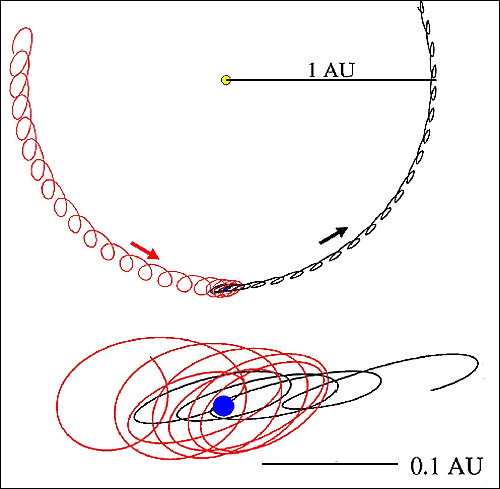In 2002, astronomers discovered asteroids in unusual orbits that bring them near Earth for extended periods. The Lincoln Near Earth Asteroid Research (LINEAR) survey of close-by minor planets has identified 19 objects orbiting the Sun close enough to Earth that our planet’s gravity has a substantial influence on their paths. All are 100-meter-wide (300-foot) wide boulders traveling in orbits shaped very much like Earth’s, but angled out of the plane of Earth’s path.
Of this elite asteroid group, three are known to “slosh” around the Earth in bizarre horseshoe-shaped orbits. Occasionally, the objects become trapped by our planet’s gravity and, for a few decades, become “quasi-satellites.” The only current quasi-satellite of Earth is 2003 YN107, which began its moon-like phase in 1996 and will end it in 2006. Astronomers calculate that a close pass with Earth more than a century from now finally will kick 2003 YN107 into a normal, circular orbit.
What makes the latest discovery, dubbed 2004 GU9, of great interest to astronomers is the remarkable stability of its orbit. It has remained a quasi-satellite of Earth for at least 600 years. Before this phase, the object traveled in a horseshoe-shaped orbit that astronomers have tracked back at least 50,000 years. According to Martin Connors of Athabasca University in Alberta, Canada, 2004 GU9 is the first object in its class to maintain a long stretch of orbital stability. Connors presented his team’s study of the object at the 2004 Joint Assembly of the American and Canadian Geophysical Unions, held this week in Montreal, Canada.
“Horseshoe objects come in from the asteroid belt, and get deflected into these orbits with lifetimes that are significantly shorter. This is why this new object is so intriguing — because it appears to have such a long lifetime,” Connors says. Although the asteroids orbit the Sun, the orbits look horseshoe-shaped when viewed from Earth’s frame of reference.
The orbits of these asteroids are more steeply inclined to Earth’s, which greatly increases the cost of any spacecraft mission due to the energy required to fly out of the solar system’s plane. “Unfortunately, we don’t expect to find any with low inclinations that are both stable and good targets for future missions,” explains Connors.
But while quasi-satellites are only temporary cohabitants, Connor believes Earth may have collected a few permanent residents we haven’t yet discovered. Jupiter has a collection of 1,664 so-called Trojan asteroids that lead and follow the planet as it orbits the Sun, and astronomers have identified a single Trojan object at Neptune.
Theoretical studies have shown that Earth may be able to retain Trojan satellites, too. “The question remains, is there stuff out there that was around at the time of the formation of the Earth and has just hung around our Trojan points?” he asks. “Before Earth formed, there could have been primordial material piling up in that region and it’s just stayed there.”
Although past searches for Earth Trojans have come up blank, Connors plans to continue his hunt for the elusive objects using the Canada-France-Hawaii telescope on Mauna Kea, Hawaii, later this year.










